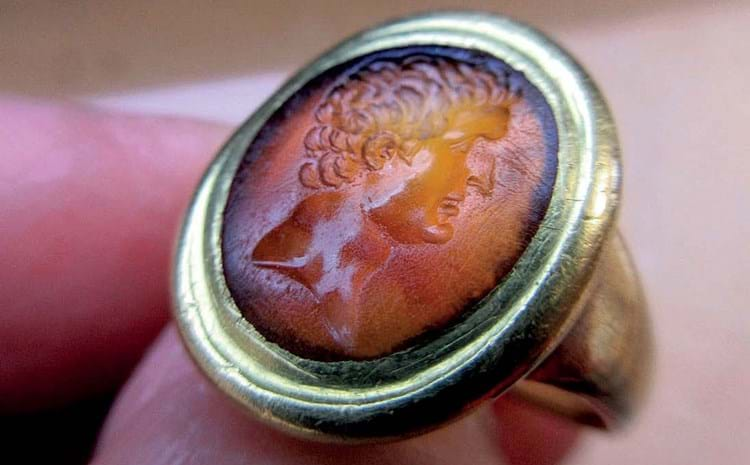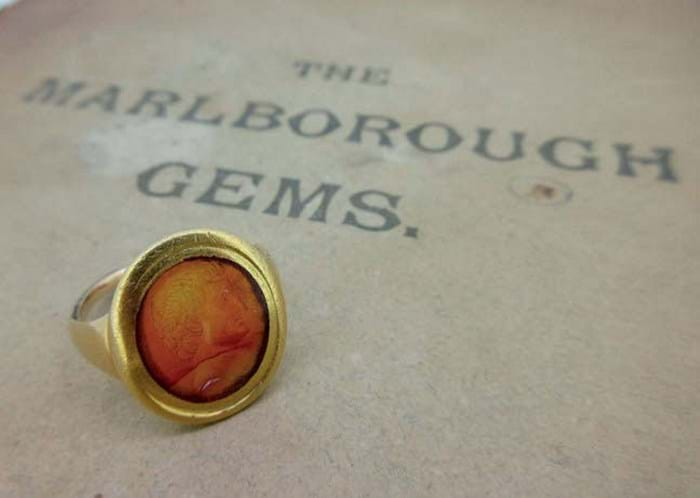
The Grand Tour-era gold ring with an earlier Roman intaglio of a clean-shaven man was sold at Cheffins on December 12 together with a copy of the hardback Christie’s catalogue from June 1899 of the sale of The Marlborough Gems, at which, according to family tradition, it was bought.
The collection of about 800 engraved gems formed by the nobleman and politician George Spencer, 4th Duke of Marlborough (1739-1817), was the largest and most important of the age. It resided at Blenheim Palace until it was sold by the 6th Duke en bloc at Christie, Manson & Woods in 1875 to David Bromilow (1809-98) of Bitteswell Hall, Leicestershire, for £35,000. The valuation was conducted by ‘the eminent expert Signor Castellani’, the celebrated Italian revivalist jeweller. It was then dispersed piecemeal by Christie’s again in June 1899.
The present whereabouts of two-thirds of the gems sold in the auction is now unknown although the Beazley archive in Oxford possesses impressions and electrotype copies of virtually every Marlborough gem as well as the cataloguer’s notebooks. It was these that were published in 2009 as The Marlborough Gems: Formerly at Blenheim Palace, Oxfordshire.
Although cautiously catalogued, the ring at Cheffins – sold way above the £300-500 estimate to a UK dealer underbid by a local private buyer in the room – is indeed listed among the ‘lost’ jewels.

One of the lost Marlborough gems, sold for £36,000 at Cheffins.
Mark Anthony
This is the gem sold as lot 378 in the Christie’s catalogue where it is described as the face of Mark Anthony in golden sard. The description adds: “The face to the right is somewhat less hard in feature than on coins and thus bears some resemblance to Vespasian. It seems a contemporary work, and in the finest manner, of the Graeco Roman period.”
Another of the ‘lost’ Marlborough jewels surfaced at Woolley & Wallis in Salisbury on July 18. After some last-minute cataloguing, this Renaissance period sapphire intaglio carved with the bust of a Roman emperor (probably Julius Caesar) sold for £62,000. It was described in the 1899 catalogue as ‘an Arundel gem’, a reference to the collection assembled by the courtier and grand tourist Thomas Howard, 21st Earl of Arundel (1585-1646).
The Arundel gems, many acquired through his agent William Petty (c.1585-1639) in Italy, passed by descent to Charles Spencer, 3rd Duke of Marlborough (1706-58).
The year 2019 marked a renaissance for commercial interest in intaglio gems. It began with the sale of a sardonyx cameo ring by English engraver Nathaniel Marchant (1739-1816) for £39,000 (plus 20% buyer’s premium) at Tennants of Leyburn on January 12.
More elements of the Marlborough collection formed part of Christie’s $8.63m (£6.69m) sale in April titled Masterpieces in Miniature: Ancient Engraved Gems Formerly in the G. Sangiorgi Collection (half were purchased by the Getty Museum), while in October St James’s dealer Wartski enjoyed queues for its exhibition of glyphic art titled Multum in Parvo.














